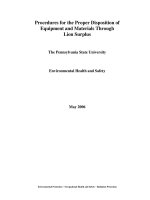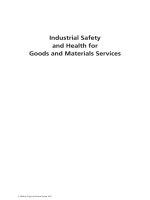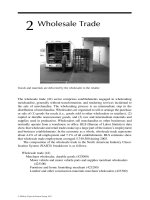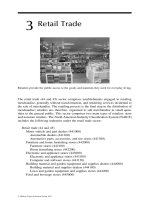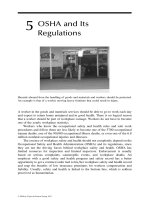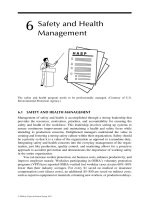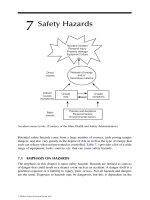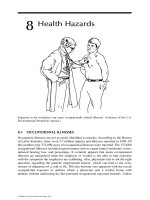Industrial Safety and Health for Goods and Materials Services - Chapter 12 pot
Bạn đang xem bản rút gọn của tài liệu. Xem và tải ngay bản đầy đủ của tài liệu tại đây (173.98 KB, 12 trang )
12
Emergencies
It is doubtful whether any industry can do away with emergency planning. Wherever
there are workers there is always potential for human emergencies such as injury,
illness, death, violence, and medical emergencies. The weather and environment can
also cause natural emergencies such as storms, floods, earthquakes, and tornados.
Man-made emergencies, such as fire, explosion, or chemical spills, cannot be over-
looked either. The key is to be the best possi bly prepared to react to any emergency.
This requires a number of issues to be addressed.
12.1 IDENTIFICATION OF HAZARDS
When looking at what hazards exist in a workplace, it is imperative that a worst-case
scenario approach be employed. It is virtually impossible to address each possible
hazard, but each industry has areas where it is most vulnerable or most at risk of an
unplanned emergency. A risk assessment will allow prioritizing the potential risk. At
this point an action plan can be developed to address the hazards that have been
Bell
Fire alarm box
with pull handle
Local emergency
number
Telephone
Fire
Alarm
Responses to emergencies should be planned in advance and alarms and warning devices in
place. (Courtesy of the Department of Energy.)
ß 2008 by Taylor & Francis Group, LLC.
identified. Some of the common hazards that might be identified as having an impact
on the workplace are as follows:
.
Fire
.
Explosion
.
Natural gas leak
.
Chemical spill
.
Release of radioactive materials
.
Airborne chemical or biological releases
.
Power outage
.
Loss of communications
.
Water leak
.
Flooding
.
Earthquakes
.
Winter storms
.
Windstorms
.
Hurricanes
.
Tornados
.
Security issues
.
Bomb threat
.
Suspicious letter or package
.
Civil strife
.
War
.
Sabotage
.
Labor strike
.
Accidents (injuries, illnesses, and deaths)
.
Mechanical failure
.
Transportation incidents (truck, rail, or air)
.
Workplace violence
The best way is to prepare to respond to an emergency before it happens. Few people
can think clearly and logically in a crisis, so it is important to do this in advance,
when you have time to be thorough.
12.2 EMERGENCY ACTION PLANS
An emergency action plan (EAP) covers designated actions employers and employees
must take to ensure employee safety from fire and other emergencies. Not all
employers are required to establish an EAP.
If an employer has less than 10 employees, the plan can be comm unicated orally.
If, on the other hand, an employer has more than 10 employees, the plan must be
written, kept in the workplace, and available for employee review.
It would be unusual for retai l, wholesal e, or warehousing sectors to not have to
comply with portable fire extinguisher regulations (1910.157) or use a fixed fire
suppression system. If an employer is regulated as above then the employer would
ß 2008 by Taylor & Francis Group, LLC.
need to develop an EAP. Figure 12.1 provides a decis ion chart for determining if an
employer needs an EAP.
When developing your EAP, it is a good idea to look at a wide variety of
potential emergencies that could occur in your workplace. It should be tailored to
your worksite and include information about all potential sources of emergencies.
Developing an EAP means you should do a hazard assessment to determine what, if
any, physical or chemical hazards in your workplaces could cause an emergency. If
you have more than one worksite, each site shoul d have an EAP.
12.2.1 ELEMENTS OF AN EAP
At a minimum, your EAP must include the following:
.
A preferred method for reporting fires and other emergencies
.
An evacuation policy and procedure including type of evacuat ion and exit
route assignment
.
Procedures to account for all employees after evacuation
.
Emergency escape procedures and route assignments, such as floor plans,
workplace maps, and safe or refuge areas
Do you need an EAP
under 1910.38(a)?
Standards that refer to 1910.38(a) Emergency Action Plan (EAP)
and additional emergency planning procedures
Are you required
to comply with
1910.157
portable fire
extinguishers?
If all of your
employees
evacuate
during a fire
emergency
Develop an EAP and a
Fire Prevention Plan under
1910.38(b), plus you may
have to comply with
1910.157(e) and (f)
Develop an EAP and
comply with 1910.157 (c),
(e), (f), (g)(3) and (g)(4)
Develop an EAP and
address the delay in it
Develop an EAP
Develop an EAP
Develop an EAP
Develop an EAP and
include procedures for
handling small releases,
plus you may be subject
to 1910.120(a), (p) and (q)
Develop an EAP
If some
employees
fight fires,
but others
evacuate
during a fire
emergency
If you have a
total flooding
system
where the
extinguishing
agent’s
concentrations
exceed levels
discussed in
1910.162(b)(5)
and (b)(6)
If the
alarms or
devices
initiated by
fire detector
actuation are
delayed >30
s
If all
employees
evacuate
and
none
provide
emergency
response
Do you use a
fixed fire
suppression
system?
Are you required
to comply with
1910.119
process safety
management for
highly hazardous
chemicals?
Are you required
to comply with
1910.1047
ethylene oxide,
1910.1050
methylenedianiline,
or 1910.1051
1,3-butadiene?
Are you required
to comply with
1910.120
hazardous waste
operations and
emergency
response
Paragraphs (1).
(p)(8), or (q)?
Are you required
to comply with
1910.272
grain handling
facilities?
FIGURE 12.1 Decision chart for determining the need for an EAP. (Courtesy of the
Occupational Safety and Health Administration.)
ß 2008 by Taylor & Francis Group, LLC.
.
Names, titles, departments, and telephone numbers of individuals both
within and outside your company to contact for additional information or
explanation of duties and responsibilities under the emergency plan
.
Procedures for employees who remain to perform or shut down critical
plant operations, operate fire extinguishers, or perform other essent ial
services that cannot be shut down for every emergency alarm before
evacuating
.
Alarm system to alert workers
.
Rescue and medical duties for any workers designated to perform them
In addition, although they are not specifically required by Occupational Safety and
Health Administration (OSHA), you may find it helpful to include in your plan the
following:
.
Designate and train employees to assist in a safe and orderly evacuation of
other employees, including those who have handicaps
.
The site of an alternative communications center to be used in the event of a
fire or explosion
.
A secure on- or offsite locat ion to store originals or duplicate copies of
accounting records, legal documents, your employees’ emergency contact
lists, and other essential records
The EAP needs to be reviewed with each employee trained on it when the plan is
developed and when an employee is assigned initially to a job, plan is changed, or
employees have specific responsibilities under the plan.
12.3 ALARM SYSTEM
Your plan must include a way to alert employees, including disabled workers, to
evacuate or take alternative action, and how to report emergencies, as required.
Among the steps you must take are the following:
.
Make sure alarms are distinctive and recognized by all employees as a
signal to evacuate the work area or perform actions identified in your p lan.
.
Make available an emergency communications system such as a public
address system, portable radio unit, or other means to notify employees of
the emergency and to contact local law enforcement, the fire department,
and others.
.
Stipulate that alarms must be audible, seen, or otherwise perceived by
everyone in the workplace. It might be good to consider providing an
auxiliary power supply in the event of a power breakdown. (29 CFR
1910.165(b)(2) offers more information on alarms.)
The following may also be considered, although it is not specifically required
by OSHA:
ß 2008 by Taylor & Francis Group, LLC.
.
Using tactile devices to alert employees who would not otherwise be able to
recognize an audible or visual alarm (Figure 12.2)
.
Providing an updated list of key personnel such as the manager or phys-
ician, in order of priority, to notify in the event of an emergency during off-
duty hours
12.4 EVACUATION PLAN AND POLICY
A disorganized evacuation can result in confusion, injury, and proper ty damage.
That is why when developing your EAP it is important to determine the following:
.
Conditions under which an evacuation would be necessary.
.
A clear chain of command and designation of the person in your business
authorized to order an evacuation or shutdown. You may want to designate
an ‘‘evacuation warden’’ to assist others in an evacuation and to account for
personnel.
.
Specific evacuation procedures, including routes and exits. Post these
procedures where they are easily accessible to all employees.
.
Procedures for assisting people with disabilities or who do not speak
English.
.
Designation of what, if any, employees will continue or shut down critical
operations during an evacuation. These people must be capable of recog-
nizing when to abandon the operation and evacuate themselves.
.
A system for accounting for personnel following an evacuation. Consider
employees’ transportation needs for community-wide evacuations.
FIGURE 12.2 Both an audible and visual alarm.
ß 2008 by Taylor & Francis Group, LLC.
In the event of an emergency, local emergency officials may order you to evacuate
your premises. In some cases, they may instruct you to shut off the water, gas, and
electricity. If you have access to radio or television, listen to newscasts to keep
informed and follow whatever official orders you receive.
In other cases, a designated person within your business should be responsible
for making the decision to evacuate or shut down operations. Protecting the health
and safety of everyone in the facility should be the first priority. In the event of a fire,
an immediate evacuation to a predetermined area away from the facility is the best
way to protect employees. On the other hand, evacuating employees may not be the
best response to an emergency such as a toxic gas release at a facility across town
from your business.
12.5 EMERGENCY RESPONSIBILITY
When drafting your EAP, you may wish to select a responsible individual to lead
and coordinate the emergency plan and evacuation. It is critical that employees
know who the coordinator is and understand that person has the authority to make
decisions during emergencies. The coordinator should be responsible for the
following:
.
Assessing the situation to determine whether an emergency is present that
requires activation of your emergency procedures
.
Supervising all efforts in the area, including evacuating personnel
.
Coordinating outside emergency services, such as medical aid and local
fire departments, and ensuring that they are available and notified when
necessary
.
Directing the shutdown of work operations when required
It may also be beneficial to coordinate the action plan with other employers when
several employers share the worksite, although OSHA standards do not specifically
require this.
In addition to a coordinator, it could be a good idea to designate evacuation
wardens to help move employees from danger to safe areas during an emergency.
Generally, 1 warden for every 20 employees should be adequate, and the appropriate
number of wardens should be available at all times during working hours.
Employees designated to assist in emergency evacuation procedures should be
trained in the complete workplace layout and various alternative escape routes. All
employees and those designated to assist in emergencies should be made aware of
employees with special needs who may require extra assistance, how to use the
buddy system, and hazardous areas to avoid during an emergency evacuation.
12.6 EXIT ROUTES
Usually, a workplace must have at least two exit routes for prompt evacuation.
But more than two exits are required if the number of employees, size of the
building, or arrange ment of the workplace will not allow a safe evacuation.
ß 2008 by Taylor & Francis Group, LLC.
Exit routes must be located as far away as practical from each other in case one is
blocked by fire or smoke.
12.6.1 REQUIREMENTS FOR EXITS
Exits must be separated form the workplace by fire-resistant materials—that is, 1 h
fire-resistance rating if the exit connects three or fewer stories, and a 2 h fire-
resistance rating if the exit connects more than three stories.
Exits can have only those openings necessary to allow access to the exit from
occupied areas of the workplace or to the exit discharge. Openings must be protected
by a self-closing, approved fire door that remains closed or automatically closes in an
emergency. Maintain a line-of-sight to exit signs clearly visible always and install
‘‘Exit’’ signs using plainly legible letters (Figure 12.3).
12.6.2 SAFETY FEATURES FOR EXIT ROUTES
The safety features exit routes are as follows:
.
Keep exit routes free of explosives or highly flammable furnishings and
other decorations.
.
Arrange exit routes so employees will not have to travel toward high-hazard
areas unless the path of travel is effectively shield ed from the high-
hazard area.
.
Ensure the exit routes are free and unobstructed by materials, equipment,
locked doors, or dead-end corridors.
.
Provide adequate lighting for exit routes for employees with normal vision.
FIGURE 12.3 A properly labeled exit.
ß 2008 by Taylor & Francis Group, LLC.
.
Keep exit route doors free of decorations or signs that obscur e the visi bility
of exit doo rs.
.
Post signs along the exit access indicati ng the direc tion of travel to the
neares t exit and exit discharge if that direc tion is not immedi ately apparen t.
.
Mark doors and passag es along an exit access that could be mistaken for an
exit ‘‘Not an exit ’’ o r with a sign identifyi ng its use such as ‘‘ Closet. ’’
.
Renew fi re-retarda nt paint s or solution when needed.
.
Maintain ex it routes during const ruction, repai rs, or alterations.
12.6.3 DESIGN AND C ONSTRUCTION OF E XITS
The requireme nts for design and const ruction of exit s are as follows:
.
Exit route s must be perm anent parts of the workplace .
.
Exit discharges must lead directly outside or to a street, wal kway, refuge
area, publi c way, or open space with access to the outsid e.
.
Exit d ischarge areas must be large enough to accom modate people like ly to
use the exit route .
.
Exit route doors must unlock from the insi de. The y must be free of devices
or alarm s that c ould rest rict use of the exit route if the device or alarm fails.
.
Exit route s can be connecte d to room s only by side-h inged doors, which
must swing out in the direc tion of trave l if the room may be occupied by
more than 50 people .
.
Exit route s must suppor t the maxi mum perm itted occupant load for each
floor served , and the cap acity o f an exit route may not decreas e in the
direction of exit route travel to the exit discharge.
.
An exit access must have ceilings at least 7 ft 6 in. high.
.
An exit access must be at least 28 in. wide at all p oints. Objects that project
into the exit must no t reduce its width (Figur e 12.4).
12.7 ACCOUNTING FOR EVACUEES
Accounting for all employees following an evacuation is critical. Confusion in the
assembly areas can lead to delays in rescuing anyone trapped in the building, or
unnecessary and dangerous search-and-rescue operations. To ensure the fastest, most
accurate accountability of your employees, you may want to consider including the
following steps in your EAP:
.
Designate assembly areas where employees should gather after evacuation.
.
Take a head count after the evacuation. Identify the names and last known
locations of anyone not accounted for and pass them to the of ficial in
charge.
.
Establish a method for accounting for non-employees such as suppliers and
customers.
.
Establish procedures for further evacuation in case the incident expands.
This may consist of sending employees home by normal means or providing
them with transportation to an offsite location.
ß 2008 by Taylor & Francis Group, LLC.
12.8 RESCUE OPERATIONS
It takes more than just willing hands to save lives. Untrained individuals may
endanger themselves and those they are trying to rescue. For this reason, it is
generally wise to leave rescue work to those who are trained, equipped, and certified
to conduct rescues.
12.9 MEDICAL CARE IN EMERGENCIES
If your company does not have a formal medical program, investigate ways to
provide medical and first-aid services. If medical facilities are available near your
worksite, make arrangements for them to handle emergency cases. Provide your
employees with a written emergency medical procedu re to minimize confusion
during an emergency.
If an infirmary, clinic, or hospital is not in close proximity to the workplace,
ensure that onsite person s have adequate training in first aid. The American Red
Cross, some insurance providers, local safety councils, fire departments, or other
resources may be able to provide this training. Treatment of a serious injury should
begin within 3–4 min of the accident.
Consult with a physician to order appropriate first-aid supplies for emergencies.
Medical personnel must be access ible to provide advice and consultation in resolving
health problems that occur in the workplace. Establish a relationship with a local
ambulance service so transportation is readily available for emergencies.
FIGURE 12.4 A well-designed emergency exit.
ß 2008 by Taylor & Francis Group, LLC.
12.10 TRAINING EMPLOYEES
Educate employees about the types of emergencies that may occur and train them in
the proper course of action. The size of your workplace and workforce, processes
used, materials handled, and the a vailability of onsite or outside resources will
determine your training requirements. Be sure all employees understand the function
and elements of your EAP, including types of potential emergencies, reporting
procedures, alarm systems, evacuation plans, and shutdown procedures. Discuss
any special hazards you may have onsite such as flammable materials, toxic chem-
icals, radioactive sources, or water-rea ctive substances. Clearly communicate to
employees who will be in charge during an emergency to minimize confusion.
Generally, training for employees should address the following:
.
Individual roles and responsibilities
.
Threats, hazards, and protective actions
.
Notification, warning, and communications procedures
.
Means for locating family members in an emergency
.
Emergency response procedures
.
Evacuation, shelter, and accountability procedures
.
Location and use of common emergency equipment
.
Emergency shutdown procedures
Also, training employees in first-aid procedures, including protection against
bloodborne pathogens, respiratory protection, including use of an escape-only respir-
ator, and methods for preventing unauthorized access to the site might be appropriate.
Once the EAP has been reviewed with employees and everyone has had
the proper training, it is a good idea to hold practice drills as often as necessary
to keep employees prepared. Include outside resources such as fire and police
departments when possible. After each drill, gather management and employees
to evaluate the effectiveness of the drill. Identify the strengths and weaknesses of
your plan and work to improve it. Review your plan with all employees and
consider requiring annual training in the plan. Also offer training when you do the
following:
.
Develop your initial plan.
.
Hire new employees.
.
Introduce new equipment, materials, or processes into the workplace that
affect evacuation routes.
.
Change the layout or design of the facility.
.
Revise or update your emergency procedures.
12.11 HAZARDOUS SUBSTANCES
No matter what kind of business exists, the potentiality for an emergency involving
hazardous materials such as flammable, explosive, toxic, noxious, corrosive, bio-
logical, oxidizable, or radioactive substances is always a possibility.
ß 2008 by Taylor & Francis Group, LLC.
The source of the hazardous substances could be external, such as a local
chemical plant that catches fire or an oil truck that overturns on a nearby freeway.
The source may be within the wor kplace or facility. Regardless of the source, these
events could have a direct impact on your employees and your business and shoul d
be addressed by your EAP.
If hazardous substances are used or stored at the worksite, there may be an
increased risk of an emergency involving hazardous materials, and this possibility
should be addressed in your EAP. OSHA’s Hazard Communication Standard (29 CFR
1910.1200) requires employers who use hazardous chemicals to keep an inventory,
display the relevant manufacturer-supplied material safety data sheets (MSDSs) in a
place accessible to workers, label chemical containers with their hazards, and train
employees in ways to protect themselves against those hazards. A good way to start is
to determine from your hazardous chemical inventory what hazardous chemicals you
use and to gather the MSDSs for the chemicals. MSDSs describe the hazards that a
chemical may present, list the necessary precautions when handling, storing, or using
the substance, and outline emergency and first-aid procedures.
12.12 EMERGENCY EQUIPMENT
Employees may need personal protective equipment (PPE) to evacuate during an
emergency. PPE must be based on the potential hazards in the workplace. Assess your
workplace to determine potential hazards and the appropriate controls and protective
equipment for those hazards. PPE may include items such as the following:
.
Safety glasses, goggles, or face shields for eye protection
.
Hard hats and safety shoes for head and foot protection
.
Proper respirators
.
Chemical suits, gloves, hoods, and boots for body protection from chemicals
.
Special body protection for abnormal environmental conditions such as
extreme temperatures
.
Any other special equipment or warning devices necessary for hazards
unique to your worksite
Consult with a health and safety professional or an industri al hygienist before
making any purchases. Respirators selected should be appropriate to the hazards in
your workplace, meet OSHA standards criteria, and be certified by the National
Institute for Occupational Safety and Health. Respiratory protection may be neces-
sary if your employees must pass through toxic atmospheres of dust, mists, gases, or
vapors, or through oxygen-deficient areas while evacuating.
12.13 SUMMARY
Emergencies are always a possibility. Reacting late to an emergency can be disas-
trous and be detrimental to any employer’s business. The preplanning can actually
save a business by decreasing liability and preventing the harm that can occur to the
workforce and the workplace itself. Employers should undertake emergency plan-
ning seriously and as a good business practice.
ß 2008 by Taylor & Francis Group, LLC.
ß 2008 by Taylor & Francis Group, LLC.
